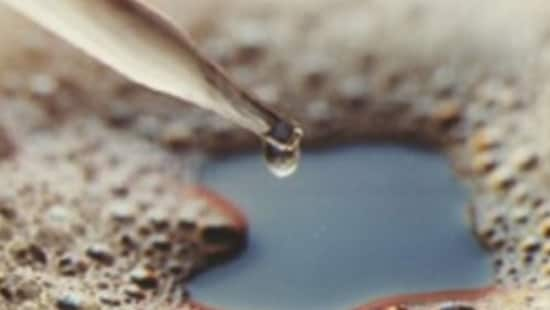The Role of Foam Control in Wastewater Treatment: Best Techniques and Techniques
The Role of Foam Control in Wastewater Treatment: Best Techniques and Techniques
Blog Article
Effective Techniques for Accomplishing Optimum Foam Control in Chemical Production
Reliable foam control is an essential aspect of chemical production that can significantly impact production performance and product high quality. By recognizing the mechanisms of foam formation and choosing appropriate anti-foaming representatives, producers can take proactive procedures to minimize excessive foam. Additionally, the application of procedure optimization techniques and advanced tracking systems plays a crucial duty in maintaining optimal operating conditions. Nevertheless, the subtleties of these approaches can differ extensively throughout various applications, elevating vital questions about best practices and real-world implementations that merit further expedition.
Recognizing Foam Formation

Surfactants, or surface-active representatives, decrease the surface area stress of the liquid, facilitating bubble security and promoting foam generation. In addition, frustration or mixing processes can enhance bubble formation, usually exacerbating foam concerns. The attributes of the liquid tool, including viscosity and density, further impact foam habits; for example, even more viscous liquids tend to catch air better, leading to raised foam stability.
Comprehending these fundamental elements of foam development is important for effective foam control in chemical manufacturing. By identifying the conditions that promote foam growth, manufacturers can carry out targeted strategies to reduce its damaging impacts, therefore optimizing production processes and guaranteeing constant item quality. This foundational expertise is important prior to discovering specific methods for managing foam in commercial setups.
Selection of Anti-Foaming Agents
When choosing anti-foaming representatives, it is vital to think about the details characteristics of the chemical process and the type of foam being produced (Foam Control). Different aspects influence the efficiency of an anti-foaming representative, including its chemical make-up, temperature level security, and compatibility with various other procedure products
Silicone-based anti-foams are commonly utilized as a result of their high effectiveness and broad temperature variety. They work by minimizing surface area stress, allowing the foam bubbles to integrate and damage even more conveniently. They may not be suitable for all applications, particularly those entailing delicate solutions where silicone contamination is a worry.
On the other hand, non-silicone agents, such as mineral oils or natural compounds, can be beneficial in specific circumstances, specifically when silicone deposits are unfavorable. These agents often tend to be much less efficient at higher temperature levels yet can supply efficient foam control in other problems.
Furthermore, understanding the foam's origin-- whether it arises from oygenation, agitation, or chain reactions-- overviews the selection procedure. Checking under actual operating problems is essential to make sure that the chosen anti-foaming representative satisfies the unique needs of the chemical manufacturing procedure successfully.
Process Optimization Methods
Effective foam control is a crucial aspect of maximizing chemical manufacturing procedures. To enhance performance and reduce manufacturing article expenses, suppliers need to implement targeted procedure optimization techniques. One critical technique entails changing blending speeds and arrangements. By fine-tuning these parameters, drivers can reduce disturbance, thereby reducing foam development during mixing.
In addition, regulating temperature and pressure within the system can substantially influence foam generation. Lowering the temperature may minimize the volatility of particular components, resulting in reduced foam. Keeping optimum stress degrees aids in mitigating extreme gas launch, which adds to foam security.
An additional reliable method is the strategic addition of anti-foaming representatives at critical points of the process. Careful timing and dosage can guarantee that these agents efficiently suppress foam without disrupting other process criteria.
In addition, including an organized analysis of resources residential or commercial properties can assist identify inherently frothing compounds, enabling preemptive steps. Carrying out regular audits and procedure evaluations can reveal inadequacies and locations for improvement, allowing constant optimization of foam control strategies.
Surveillance and Control Solution
Monitoring and control systems play an essential duty in preserving optimal foam monitoring throughout the chemical manufacturing procedure. These systems are vital for real-time observation and modification of foam levels, ensuring that manufacturing efficiency is made the most of while minimizing interruptions triggered by extreme foam development.
Advanced sensors and instrumentation are used to discover foam thickness and height, giving vital information that informs control algorithms. This data-driven technique enables the timely application of antifoaming agents, making certain that foam levels continue to be within acceptable limitations. By integrating surveillance systems with procedure control software, makers can implement computerized reactions to foam changes, decreasing the demand for manual intervention and boosting functional consistency.
Additionally, the assimilation of device discovering and anticipating analytics right into keeping track of systems can promote proactive foam management. By examining historic foam information and functional parameters, these systems can forecast foam generation patterns and suggest preemptive actions. Regular calibration and maintenance of tracking devices are necessary to ensure accuracy and dependability in foam detection.
Eventually, effective monitoring and control systems are important for enhancing foam control, advertising security, and enhancing general efficiency in chemical production atmospheres.

Instance Studies and Best Practices
Real-world applications of surveillance and control systems highlight the importance of foam administration in chemical manufacturing. A remarkable instance study includes a large pharmaceutical manufacturer that carried out an automated foam discovery system. By incorporating real-time surveillance with anticipating analytics, the facility reduced foam-related production downtime by 30%. The data-driven other approach permitted prompt treatments, making sure regular item quality and operational efficiency.
One more exemplary case originates from a petrochemical business that took on a mix of antifoam agents and process optimization techniques. By evaluating foam generation patterns, the organization customized its antifoam dose, causing a 25% decrease in chemical use and substantial cost savings. This targeted method not just minimized foam interference but also boosted the general stability of the production procedure.

Verdict
Finally, achieving optimum foam control in chemical manufacturing demands an extensive approach incorporating the choice of ideal anti-foaming representatives, execution of process optimization methods, and the assimilation of innovative surveillance systems. Regular audits and training even more improve the performance of these approaches, fostering a culture of constant renovation. By attending to foam formation proactively, makers can dramatically improve manufacturing performance and item high quality, inevitably contributing to more economical and sustainable operations.
By understanding the mechanisms of foam development and choosing ideal anti-foaming representatives, producers can take aggressive procedures to alleviate extreme foam. The features of the fluid medium, including thickness and density, further impact foam habits; for example, even more viscous liquids often tend to catch air a lot more successfully, leading to raised foam security.
Understanding these essential aspects of foam formation is crucial for effective foam control in chemical production. By evaluating historical foam data and functional parameters, these systems can anticipate visit the website foam generation patterns and recommend preemptive steps. Foam Control. Normal audits of foam control determines ensure that procedures stay optimized, while cultivating a culture of positive foam administration can lead to sustainable improvements throughout the manufacturing range
Report this page